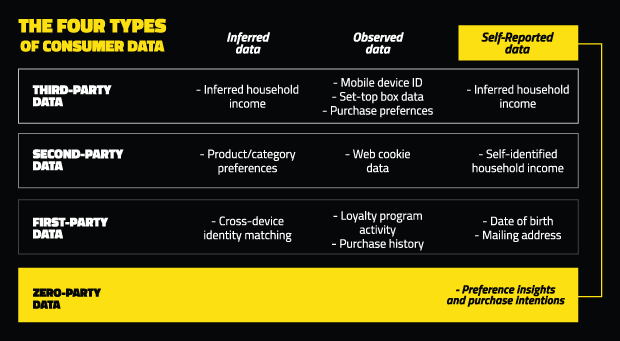We grow by sharing our experience, knowledge and expertise/

The personalization-privacy paradox and how the combination of zero- and first-party data will make or break your marketing.
Most of us love the idea of people knowing what we want and without asking giving it to us. At the same time most of us hate the idea that these people know too much about us. It does sounds contradicting.
That pretty much describes however, what has been going on the past few years with the [justified] privacy concerns, the GDPR [General Data Protection Regulation] and CCPA [California Consumer Privacy Act], the commitment of all the major browser companies to phase out third-party cookies while at the same time 71% of consumers are not that happy when they receive an impersonal experience and 76% of consumers expect companies to understand their needs and expectations. It is along the lines of us as consumers, wanting the best of everything while we need to accept that it is, at least at this stage, a matter of a tradeoff.
In this context zero and first-party data are becoming the ideal data entity for brands and consumers. It is where the tradeoff of privacy meets the holy grail of personalized experiences.
The Data Party
Third-party, second-party, first-party data have been buzzing around for years. The zero-party is the new “party” in town. So what is it?
Zero-party data, referred to also as explicit data, is a term created by Forrester Research and refers to data that a customer intentionally and proactively shares with a brand. To get an idea these may be how to be identified by a brand, intention to buy something or personal context. The differentiator between the zero- and first- party data is in the ownership. While FPD can be owned by brands the ZPD can’t because consumers allow a brand the right to use their ZPD for the purpose of a particular intent or value exchange.
ZDP is a straightforward way in collecting data where the users knowingly and willingly share their data to get something back of value to them. This could be personalized content or offers or recommendations about services. All you need to do is ask. Enter an ongoing conversation with them where you will be in a position to ask and they would be willing to answer instead of snooping them around to try and understand them by extrapolation. It is hard work, but it is worth it because it aligns transparency of data exchange and the need of customers and brands for personalization.

How to use them?
In an interview with Google in February this year Sir Martin Sorrell phrased it very well. “I think personalization at scale is the way. That creates a model which is totally different. It’s tailored to the individual, it looks at what people are doing in a constructive way, not a destructive way, and we all produce better work.”
Make the experiences and messaging personal
While there is a huge buzz around personalization only 22% of consumers find the level of personalization they are receiving from brands satisfactory. There is a clear misalignment in the consumer expectations and what the brands actually deliver. A lot of it is attributed to the data that the personalization actions are based on. Enabling your customers to share their own preferences will elevate the quality of the data which in combination with first-party data can drive to almost complete custom experiences, content and messaging to consumers. All of these will satisfy them and elevate your brand.
Enhance your existing first-party data
The gradual dismissal of the 2nd - and 3rd - party data along with their inability to a large extend to deliver on their promise has led a lot of companies to invest in collecting and nurturing their first-party data. In this context zero-party data will enable you to seriously enhance and expand the insights into your data.
Let’s assume you are selling a SaaS product on your website and you are in a position to know the pages your leads are visiting and who signing on for a product demo. That is already great but if you could make that product demo more personal and address the specific pain points of each of your leads then your conversion rate would dramatically increase. You can do that by incorporating an on-site survey that captures this information or by making the demo dynamic in addressing on the fly their specific needs.
Build better customer relationships
Research shows that 57% of consumers are happy to share personal data in exchange for personalized experiences. And this is great news for brands that are willing to invest in what the data tells them and meet customer expectations for relevance and value. It is a long-established notion that building a solid relationship with your clients it impacts retention, customer lifetime value and advocacy. Going beyond messaging and current experiences these relationship building can be used for product or services improvements and even future product and services development.
Maximize the value of your marketing spend
The combination of first- and zero-party data can result significant savings in your marketing spend. The level of accuracy entailed in the data you have on the consumers visiting your digital assets enables you to deliver a tailored message to them without having to be investing media money over and over again to spot them out from a larger pool. This will result in more conversions and more revenues and provide you the opportunity to invest those funds in retaining clients and pursuing those with proven interest.
How do I get started?
The willingness of the consumers to give away some of their data is vastly depended on the value they believe they will gain from it. It is transactional in a sense, but it also has a lot to do with trust to a brand or an organization.
Therefore, organizations and brands need to strategically think how they operate with a data collection mindset. They need to set up the mechanisms, technologies and techniques that will engage, entertain, and provide something that is worth the customer's attention and receive willingly their preference data.
Most zero-party data is captured through interactive marketing experiences. Here are some examples of ways you can collect zero party data.
- Customer surveys
- Questionnaires
- Polls
- Email opt-ins
- Competitions
- In-app preferences
- Social media stories
- Industry reports
- White papers
- Webinars
- Newsletters
- Product updates
With a clear target on what information you wish to capture you can design your marketing initiatives to serve dual purpose at all times. Meeting your marketing objectives and your data collection objectives which will then be incorporated to your next marketing activities.
Air New Zealand's Yay to the USA campaign is a good example of this mindset. ANZ offered entrants a chance to win free flights for themselves and three friends aiming to promote and recommend a range of its US long-haul flight destinations. To do so the users had to answer six multiple-choice questions and then enter a few personal contact details to secure their entry to the sweepstake. They could also opt-in to future marketing communications, providing Air New Zealand with rich zero-party data to use for personalized retargeting. After answering the questions, users received a proposed travel destination based on their answers. In the final step a winner was drawn, and all other participants were sent a personalized email offering them a 5% discount code to buy tickets to their recommended destination within the next 30 days. The results were great leading to a great ROI 38:1 and more than 100,000 zero-party data records captured.
In a similar context we worked with METRO supermarkets a couple of years ago utilizing a Christmas campaign towards unifying data across IT systems so as to serve each customer better by delivering personalized content and offers. Building on a promotional Christmas campaign “Santa Spin & Win” we combined the existing loyalty card system with a Facebook application and a gamification concept. METRO customers were able to log in to Facebook, spin the wheel in a custom-made Facebook application and earn points and discounts directly added on their loyalty card. In addition to their Facebook log in, the customers were asked to fill in data preferences related to their loyalty card so that we could subsequently top up their loyalty card with the discount they would win. The entertainment element and consumer-friendly implementation resulted in great success both in terms of marketing and data collection KPIs.
It is strategic, again
One thing that anyone who has been reading our insights has understood over the years is our obsession to strategic view of things rather than the tactical. Good tactics without a strategic vision are doomed to fail.
In the same context this approach towards investing in collecting and nurturing zero- and first- party data needs to have a clear purpose, vision, mindset and commitment to succeed. In this way you can vastly improve how you communicate with customers
This is not a a zero-sum game. Companies and brands both benefit. Data can reduce marketing waste for a brand and improve the lives of its customers – a win-win situation for everyone involved.
Get in touch to plan for it.




